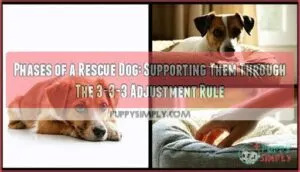This site is supported by our readers. We may earn a commission, at no cost to you, if you purchase through links.

The first 3 days, your dog may feel overwhelmed, needing quiet time to decompress.
In 3 weeks, they start settling in, learning routines, and feeling safer.
By 3 months, trust builds, and their true personality shines.
It’s like meeting a shy friend who slowly opens up once they feel secure.
Each stage has its challenges, from nervous pacing to testing boundaries, but patience and consistency are key.
With time, your rescue dog will feel at home, ready for the next chapter of their life.
Table Of Contents
- Key Takeaways
- Rescue Dog Adjustment
- Phases of Adjustment
- Pre Arrival Preparation
- Post Arrival Procedures
- Long Term Adjustment
- Frequently Asked Questions (FAQs)
- How long does it take a rescue dog to fully adjust?
- What is the 3-3-3 rule for rescue dogs?
- What is the timeline for a new rescue dog?
- What is the hardest part of adopting a rescue dog?
- What should I do if my rescue dog is showing signs of aggression?
- Are there any long-term effects of trauma in rescue dogs?
- Is it possible to bond with a rescue dog quickly?
- How can I help my dog overcome trauma?
- What signs indicate my dog is progressing well?
- How do I manage my dogs energy levels?
- Conclusion
Key Takeaways
- Give your rescue dog time by following the 3-3-3 rule: 3 days to decompress, 3 weeks to settle, and 3 months to build trust.
- Ease their anxiety with a consistent routine, a quiet space, and by gently introducing boundaries and socialization.
- Use positive reinforcement to address challenges like stress, aggression, or bad habits, while building their confidence.
- Expect their true personality to shine as trust grows and they feel secure in their new home.
Rescue Dog Adjustment
When you bring a rescue dog home, it’s important to understand their adjustment takes time.
The 3-3-3 rule helps you set realistic expectations so you can guide them through the phases of feeling overwhelmed, settling in, and building trust.
Initial 3 Days
During the initial 3 days, your rescue dog is likely overwhelmed, adjusting to life outside the dog shelter.
The first 3 days are about patience—your rescue dog is overwhelmed, learning to adapt to life beyond the shelter.
Focus on decompression strategies like providing a safe space and limiting exposure to stimuli to ease their anxiety.
Expect signs of initial anxiety, such as hiding or not eating, and practice boundary setting gently, ensuring a calm, quiet environment for a smooth new home adaptation.
Some rescue dogs may exhibit fear-based aggression during this period, which requires careful handling and calm environment to prevent escalation, and it’s crucial to prioritize their smooth adaptation.
First 3 Weeks
With the overwhelm phase easing, the next three weeks are about creating stability.
Routine establishment and bonding techniques build trust through daily patterns.
Focus on these steps:
- Basic training introduction – Start simple commands.
- Behavioral observation – Spot quirks and adjust expectations.
- Socialization start – Slowly meet pets or neighbors.
Patience guarantees rescue dog adoption remains rewarding under the 333 rule.
First 3 Months
By the first three months, your rescue dog starts feeling at home.
By three months, a rescue dog transitions from cautious to confident, forging deep bonds and thriving in a loving home.
Their personality emerges, trust deepens, and a routine solidifies.
Training consistency and socialization continue as they thrive in this phase.
Stay patient, reinforce positive behavior, and bond deeper.
Your commitment to the 333 rule guarantees a smooth new home integration.
| Phase | Behavior | Needs | Outcome |
|---|---|---|---|
| Bonding | Trust deepens | Training consistency | Stronger connection |
| Adjustment | Personality emerges | Socialization continues | Balanced behavior |
| Confidence | Routine solidifies | Encouragement through play | A well-settled dog in a happy home |
The table outlines the key phases of development, including bonding, adjustment, and confidence, highlighting the importance of socialization and training consistency in each stage.
Phases of Adjustment
Adjusting to a new home is a big change for a rescue dog, and it happens in stages.
Understanding these phases helps you provide the support they need as they move from feeling overwhelmed to building trust.
Overwhelmed Phase
During the overwhelmed phase after rescue dog adoption, expect sensory overload and fearful behavior.
Anxiety in dogs often shows through hiding, refusal to eat, or curling up in quiet spots.
Initial stressors are normal during a new home relocation, and use of decompression methods like providing a crate or calm space can be beneficial.
These steps gradually build confidence, aiding dog adjustment and acclimation.
Settling Phase
During the settling phase, your rescue dog starts adapting to their new home.
You’ll notice emerging personality traits as they explore their environment. Their behavior shifts as they lower their guard and embrace routine.
Support them by:
- Sticking to consistent daily routines.
- Allowing gradual exploration of new spaces.
- Setting firm yet positive boundaries.
- Watching for behavioral changes needing gentle guidance.
Trust Building Phase
After settling in, your rescue dog starts building trust. Bonding activities like gentle play and hand-feeding help solidify connections.
A consistent routine fosters a secure environment and makes them feel safe. Use positive reinforcement when teaching new commands or addressing dog behavior.
Understanding fear-based aggression can help owners better respond to triggers in their newly adopted dogs. Over time, affection displays like tail wags or cuddles show their growing confidence and trust in you.
Pre Arrival Preparation
Preparing for a rescue dog’s arrival means setting up your home to guarantee their safety and comfort from the start.
By planning ahead with essentials like a quiet space, proper supplies, and suitable food, you’ll help them feel secure during this big change.
Dog Proofing Home
Some things might surprise you when dogproofing your home.
Start by removing chew hazards like wires, socks, and shoes.
Toxic plants? They’ve got to go.
Child safety locks work wonders on cabinets.
Check fences for gaps to guarantee secure fencing and escape prevention.
A good start involves removing choking hazards to protect your new family member.
Creating a safe dog environment helps ease their adaptation and keeps everyone stress-free.
Purchasing Essentials
After prepping your home, it’s time to gather dog necessities.
Start with a sturdy crate and a cozy dog bed for comfort.
Add quality feeding bowls and leashes—compare brands, balancing essential budgeting with quality matters.
Shop local or online for sustainable options like washable beds.
Many owners find it convenient to buy a dog crate online for easy delivery.
Remember, smart choices support your dog’s health while keeping your wallet intact, which is a result of making quality decisions.
Researching Dog Food
Finding the right food for your rescue dog starts with ingredient analysis and understanding their dietary needs.
Compare brands, keeping allergies, life stage, and overall dog nutrition in mind.
A healthy dog diet guarantees better dog health and happiness.
Ask your vet for advice; choosing the right food can feel overwhelming, but it’s key for good dog feeding and a balanced dog diet.
Post Arrival Procedures
When your rescue dog arrives, it’s important to focus on creating a calm and structured environment right away.
From the first walk to setting boundaries, every step helps them feel secure and start adjusting to their new home.
First Day Routine
The first day sets the tone for your rescue dog’s new home adaptation.
Start with calming techniques to ease their nerves and establish their safe zone.
- Let your dog decompress by exploring quietly at their own pace.
- Perform an initial assessment of their comfort and behavior.
To help with this adaptation, consider using soothing calming products to create a peaceful environment, which is crucial for their new home adaptation.
- Use bonding activities like hand-feeding to build trust without overwhelming them.
Leash Guided Tour
A leash-guided tour helps your dog explore the new environment safely while reducing anxiety.
Walk through each room calmly, establishing leadership and allowing safe exploration. Keep the leash short but not tight to avoid leash reactivity.
Here’s a quick guide:
| Action | Purpose |
|---|---|
| Use a calm tone | Builds trust |
| Stay slow and steady | Reduces stress |
| Limit distractions | Focuses attention |
| Praise calm behavior | Encourages bonding |
| Repeat daily | Creates routine |
Establishing Boundaries
After showing your dog the house, establish boundaries by limiting access to certain areas.
Set clear dog rules and stick to them—consistency builds trust. Create a calm environment by avoiding overstimulation like loud noises or constant attention.
Use positive reinforcement for good behavior. A solid routine helps reinforce dog boundaries and teaches proper dog behavior while building mutual respect.
Long Term Adjustment
Helping your rescue dog adjust long-term takes time, patience, and consistency.
Over the months, you’ll notice their true personality emerge as they feel secure, making it the perfect stage to address challenges and reinforce good habits.
Common Challenges
Behavioral challenges like chewing, barking, or anxiety can surprise you, but they’re common. Rescue dogs need time and understanding to feel secure—patience is your secret weapon here.
- Monitor for health problems like fear or stress-related symptoms.
- Use positive reinforcement to encourage good behavior.
- Avoid overload; allow rest periods.
- Seek professional help if issues persist.
- Set realistic expectations and steady routines.
Reinforcing Good Behavior
Keeping your rescue dog on the right track means using positive reinforcement and consistent commands daily.
Reward good behavior with praise or small treats right when it happens—it’s all about timing! Avoid punishment; instead, shape behavior through encouragement.
Positive reinforcement is key when using treat based training.
| Common Behavior | Suggested Reward |
|---|---|
| Sitting on command | Treat or belly rub |
| Walking calmly on leash | Verbal praise |
| Not jumping on guests | Gentle head pat |
| Staying in assigned spot | Chew toy |
Advanced Training Options
Once good behavior sticks, it’s time for something fun!
Agility training, scent work, or trick training keeps your dog sharp and engaged.
Dog training classes, like therapy certification or Canine Good Citizen programs, teach advanced skills.
Professional training offers dog training tips and methods customized to your pup’s needs.
Consider agility course components for physical and mental stimulation.
Explore these options for an active, well-rounded companion.
Frequently Asked Questions (FAQs)
How long does it take a rescue dog to fully adjust?
Think of adjustment as a journey, not a sprint.
It takes most rescue dogs around three months to fully settle in, but every dog’s timeline varies.
Patience, consistency, and love help smooth the process.
What is the 3-3-3 rule for rescue dogs?
The 3-3-3 rule explains a rescue dog’s adjustment: in 3 days, expect nervousness; 3 weeks, settling into routines; and 3 months, building trust.
Patience, consistency, and understanding help them feel safe and at home.
What is the timeline for a new rescue dog?
Imagine bringing home a shy, shelter dog who just wants to hide.
In 3 days, they decompress, then, at 3 weeks, start adjusting.
By 3 months, they relax, trust, and show their true personality.
What is the hardest part of adopting a rescue dog?
The hardest part of adopting a rescue dog is adjusting to their fears and behaviors, as they need time to trust you.
Patience, structure, and consistency are key, even when things feel overwhelming at first.
What should I do if my rescue dog is showing signs of aggression?
It’s ironic how aggression often signals fear.
Stay calm, create space, and avoid confrontation.
Use positive reinforcement for good behavior and consult a professional trainer or behaviorist to safely address the issue and build trust.
Are there any long-term effects of trauma in rescue dogs?
Trauma can leave rescue dogs anxious or fearful, affecting trust and behavior.
You’ll notice triggers, like loud noises or new people, causing reactions.
Consistent routines, patience, and positive reinforcement help them heal and build confidence.
Is it possible to bond with a rescue dog quickly?
Bonding with a rescue dog quickly depends on patience, consistency, and trust.
Focus on gentle interactions, a steady routine, and positive reinforcement.
Over time, their trust grows, and the connection strengthens naturally with kindness and care.
How can I help my dog overcome trauma?
Help your dog heal by building trust slowly.
Use calm energy, a consistent routine, and positive reinforcement.
Give them a quiet space to decompress.
Be patient—small steps lead to big breakthroughs in overcoming trauma.
What signs indicate my dog is progressing well?
Signs your dog is progressing include relaxed body language, consistent eating, responding to commands, seeking affection, and showing curiosity.
They’ll settle into routines, play more confidently, and display their unique personality as trust builds.
How do I manage my dogs energy levels?
Keep your dog’s energy balanced with daily walks, mental stimulation like puzzle toys, and short training sessions.
Stick to a regular exercise routine while avoiding overexertion.
A tired dog is a happy, manageable companion.
Conclusion
Helping your rescue dog adjust is a journey, not a sprint, and the 3-3-3 rule offers a helpful roadmap.
By understanding the phases of a rescue dog—overwhelm, settling in, and trust building—you can approach each stage with patience and consistency.
Prepare your home, stick to routines, and reinforce positive behavior.
These efforts create a foundation for trust and security, letting your dog thrive.
With time and care, you’ll discover the joy of seeing their personality truly shine.















